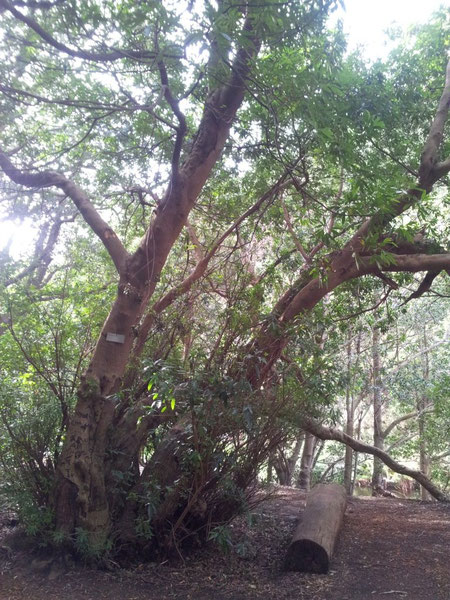Platylophus trifoliatus
 Image: S Molteno
Image: S Molteno
Description
A small to large, evergreen tree, which may reach 30 m tall. Stems of really old trees may take on rather gnarled and grotesque forms. The bark is vertically fissured, greyish initially, becoming brownish with age.Many of the trees are multi-stemmed as a result of the trees ability to coppice. Single clean-stemmed trees are seldom found. The wood varies in colour from pinkish brown or yellowish, with darker markings, to dark brown. The wood is medium-hard and medium heavy. Old trunks that are gnarled, have an attractive bird's eye grain.
Slow growing, these trees may become hundreds of years old, as a result of being able to re-sprout when the stems or branches get damaged.
Honey bees and other insects are greatly attracted to the tree, as it produces copious nectar. The bees act as pollinators for these trees. Birds and wild pigs eat the fruit and seeds. Some years ago, in the Harold Porter National Botanical Garden, baboons ripped off large chunks of the outer bark, and scraped off the inner bark with their teeth. This is the only time this has been noticed on the trees there and it is unknown why it would have been done.
Propagation instructions - cuttings
Can be grown cuttings collected in mid-summer but keep the cuttings in cool shade. They must not be exposed to stress.Be very careful in selecting the cuttings. The tree must be mature and in good condition. Look for cuttings that showed active growth which can be found near the ends of the branches. Look behind the terminal growth for side shoots that are straight, with longer internodes and show active and hardened-off growth, with the wood having changed from green to light brown. Select heel cuttings, but tip cuttings also work. The cuttings must be rooted in 50:50 milled bark and polystyrene which allows for good aeration. place in a pot just large enough for the cutting and using the rooting material and hormone (Seradix 2). Cover the tree cutting with a clear plastic bag and seal with an elastic band. You can use wire to support the plastic and keep it away from the leaves. Place out of the direct sun, in a warm, shaded place and regularly check that the rooting medium is not drying out and remove any dead leaves. You can also apply a broad spectrum fungicide drench to prevent infection. Cuttings are known to root well, using this method, but it takes longer. When the cutting starts to show signs of growing, you may assume that roots have begun developing. Check the cutting for roots and if well developed, begin the hardening-off process, by first making a slit in the plastic to allow for more air circulation. A week later, open the opening in the plastic bag further and then remove after about 2 weeks. Close up the plastic bag and slow the process if you notice the plant is showing signs of stress or desiccation. It is recommended that you water in Kelpac to feed the roots and reduce stress. Once the plant is hardened off, re-pot into a well-drained potting medium that does not contain manure. Grow the young tree on in a protected place where it gets morning sun, but not full day or hot afternoon sun, or under 40% shade cloth. Feed regularly with an organic fertilizer following the instructions.
Propagation instructions - seeds
Sow seed in the warm summer months and smoke treat as it is a tree occurring in the fynbos. Keeping the seed under glass to have higher humidity based on the natural habitat is recommended. The seed is fine and probably has little reserves. Another intervention would be to dust the seed with a pre-emergence damping off fungicide to prevent rotting/infection.'
Sources and references
Scientific name
Platylophus trifoliatus
Common name(s)
white-alder
